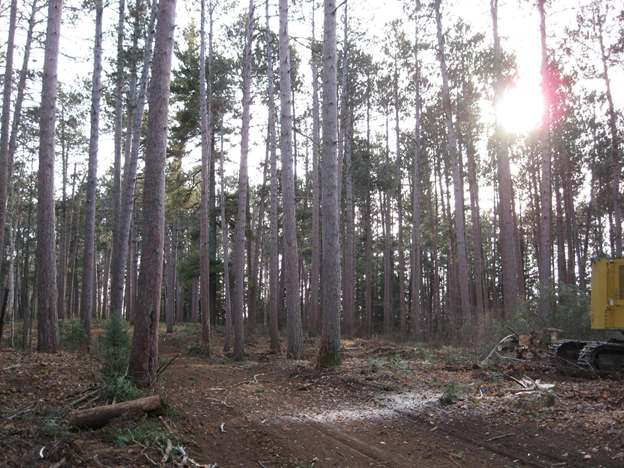Overview
Camp 8 is one of the last remaining old-growth pine forests around Cloquet. A majority of the stand originated following a fire in 1813 and structure was maintained through a high-frequency surface fire regime. The lack of fire after 1909 led to major changes in stem density and stand structure. This case study outlines a 1984 mechanical treatment designed to restore open-understory structural conditions similar to what would have been maintained by frequent low-intensity fire. The eastern half of the stand was untouched during this treatment and for comparison and demonstration.
Silviculture Objective(s)
The silvicultural objective was to restore stand structure and composition to more closely resemble what the stand would have looked like had fires continued to burn through the stand as they had in the decades before the University of Minnesota acquired the land. As noted below, later fire reconstruction research suggests that the stand experienced nine surface fires between 1841 and 1909 but none thereafter.
Pre-treatment stand description and condition
Stand establishment and management history:
Timeline of known key events in the development of the current stand. Surface fire events were identified through an intensive fire scar sampling effort conducted by Evan Larson and Adam Donaldson (both from the University of Wisconsin – Platteville) and Kyle Gill (University of Minnesota) and used here by their permission.
- 1813: Stand re-initiating fire that left few mature trees but promoted substantial regeneration.
- 1841: Surface fire
- 1855: Surface fire
- 1864: Surface fire
- 1871: Surface fire
- 1875: Surface fire
- 1881: Surface fire
- 1894: Surface fire
- 1905: Surface fire
- 1909: Surface fire
- 1909: The University of Minnesota assumes land management
- 1919: 100% cruise: 80 trees per acre, average DBH 14.6”, cubic foot volume per acre 3,170, board foot volume (Int ¼” rule) 19,000.
- Early 1920’s: No regeneration in the stand or any underbrush
- 1952: 100% cruise: 78 trees per acre, average DBH 16.6”, cubic foot volume per acre 4,090, board foot volume (Int ¼” rule) 25,200, growth per acre per year 200 board feet.
Pre-treatment species composition:
In addition to the modern NPC setting for this kind of area, the 1946 management plan for the CFC noted that the understory in Camp 8 consisted of “…northern fern, blueberry, wintergreen, and, in the openings, hazel and sweetfern.” The authors also noted that due to the density of the hazel in the understory there was no natural regeneration and all underplanting attempts had failed.
Pre-treatment forest health issues:
No major known issues. Armillaria root rot spores were known to be present in the soil in part of Camp 8 according to fungal research carried out in 1991. Some individual tree mortality occurred.
Silviculture Prescription
The treatment of the western half of Camp 8 specified that all undergrowth beneath the old growth canopy was removed; that the forest floor was left clean of tree debris to minimize fuel load in order to allow for a low intensity summer burn; and that salvageable dead trees and any live trees that showed signs of low vigor be removed. Specifically, the prescription included salvaging dead trees and those showing low vigor in the canopy and removing all understory spruce, fir, white pine, and hardwoods. The eastern half of the stand was left to continue on an untreated stand development trajectory to demonstrate the effects of fire suppression.
What actually happened during the treatment
This treatment was conducted with conventional logging equipment. In 1984 the amount and type of wood removed consisted of the following: red and white pine and balsam fir: 0.2 cords/acre, bolt; jack pine: 0.3 cords/acre, pulp; other species: 0.4 cords/acre, pulp.
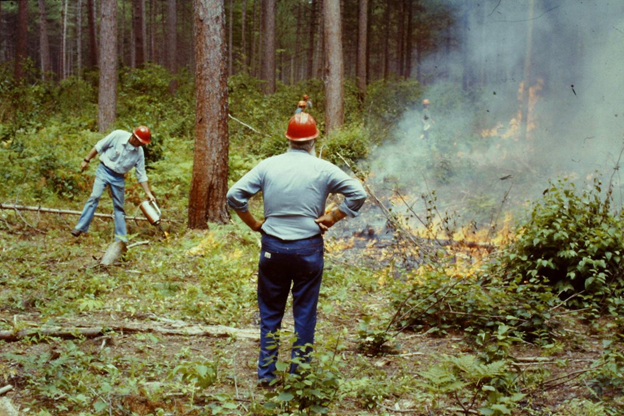
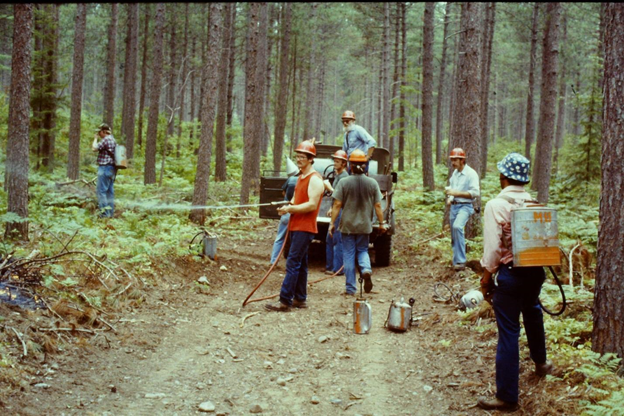
Figures 1, 2: 1984 photos showing a prescribed burn after the restoration treatment described here.
Post-treatment assessment
In 1992, Camp 8 was described as follows: “There are approximately 75 old-growth pine per acre. [These trees] have an average DBH of about 17 inches and there are approximately 26 thousand board feet (MBF) per acre. The stand today has a moderate to heavy understory of shrubs, balsam fir, spruce, white pine, and hardwoods. Present tree mortality is moderate in pockets but light throughout the stand.” Later, in the 2002 management plan, Ron Severs noted “Periodic fires could be used to control the understory in the managed portion of the stand… From 1992 to 2002… two prescribed burns were accomplished. Both burns had minimal effect on reducing woody understory vegetation. A combination of limited personnel and infrequent safe burning conditions were major limiting factors preventing effective and regular burns.”
In 2009, the 1984 treatment was repeated: 19.5 tons/acre of mixed species chips were removed from the understory. Unlike the 1984 treatment, however, some white pine regeneration was retained. Ron Severs notes in the 1992-2001 Cloquet Forestry Center Management Plan that “this prescription doesn’t include any specific recommendations for stand regeneration at this time. The presence of the disease red pine shoot blight (Sirococcus strobilinus) on the forest would preclude trying to establish regeneration under the overstory, and the time at which the stand will lose the characteristics for which it is being preserved is indeterminable.” In addition, a pocket of Armillaria mortality is believed to have formed following the 2009 treatment.
Current Stand Conditions
Camp 8 was cruised in 2018. The treated side was found to have a basal area of 160 square feet per acre; of those 160 square feet, 143, or 89 percent, were comprised of red pine and 13, or 8 percent, were comprised of white pine. Of the 93 trees per acre, there were approximately 75 red pine and 6 white pine per acre in the stand. Much of the basal area for red pine is in the 16 to 22 inch DBH classes (figure 1). There is some balsam fir around the perimeter of the untreated half, particularly on the west edge, and figure 2 shows there are approximately 12 balsam fir per acre. There are also 7 red pine snags per acre.
These numbers are in contrast to the untreated stand, where the red pine are being overloaded by other species in the smaller diameter classes such as balsam fir and red maple as well as some aspen and birch. The untreated stand has a basal area of 221 square feet per acre, and while 75% of the basal area is comprised of red pine and another 8% are white pine (figure 3), the stand is at considerable risk for a crown fire due to the density of the stand as well as the presence of ladder fuels (figure 4). In addition, there is likely little to no red or white pine regeneration due to heavy competition in the understory, particularly balsam fir. Balsam fir, while representing about 8% of the total basal area, accounts for almost a quarter of the trees per acre. There are about 23 snags per acre and almost half of them are red pine.
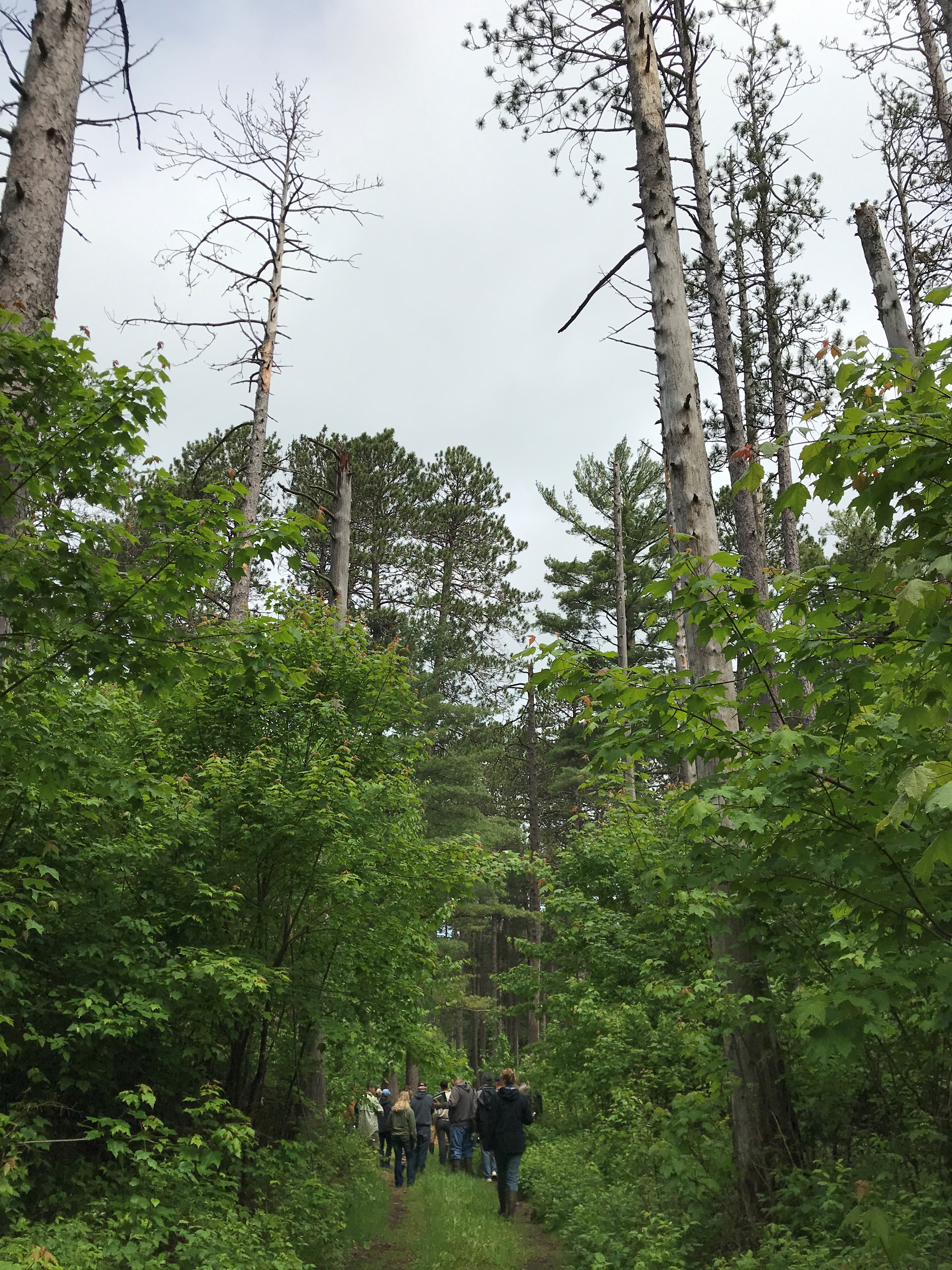
Figure 3: Red maple invading a canopy gap under mature red pine.
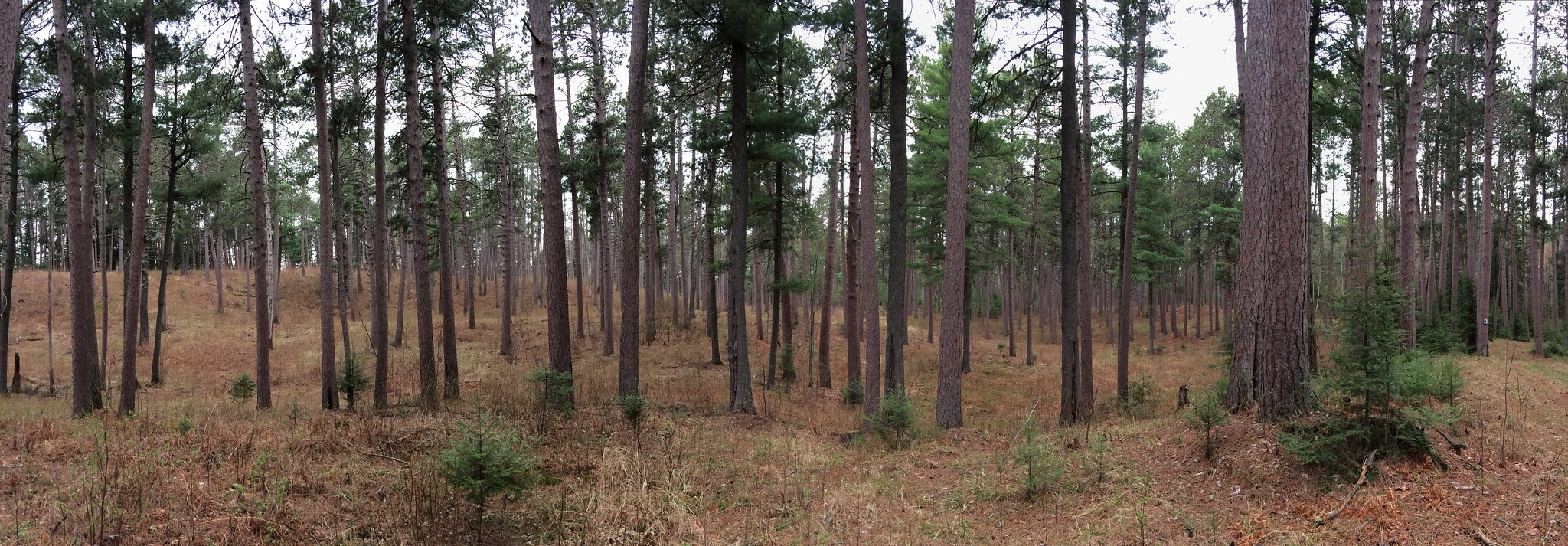
Figure 4: A panoramic image of the Camp 8 stand after treatment, showing large trees and an open understory.
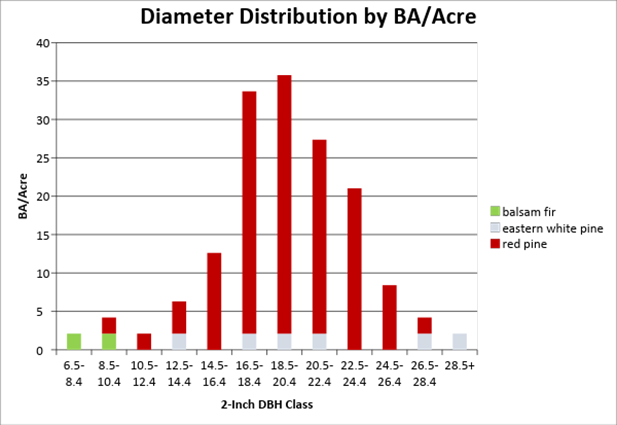
Figure 5: Diameter distribution by BA/acre of the treated area of Camp 8 in 2018, cruised with a BAF of 40
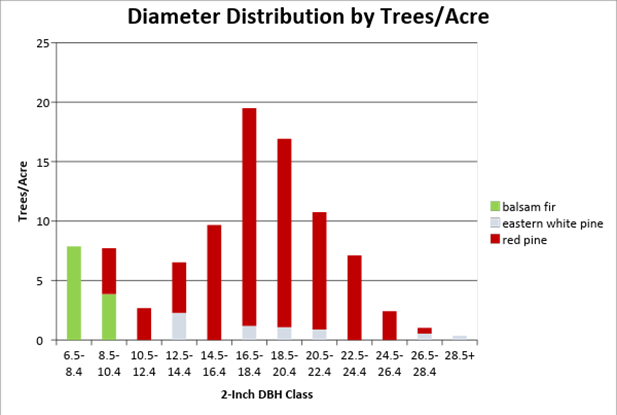
Figure 6: Diameter distribution by trees/acre of the treated area of Camp 8 in 20178, cruised with a BAF of 40
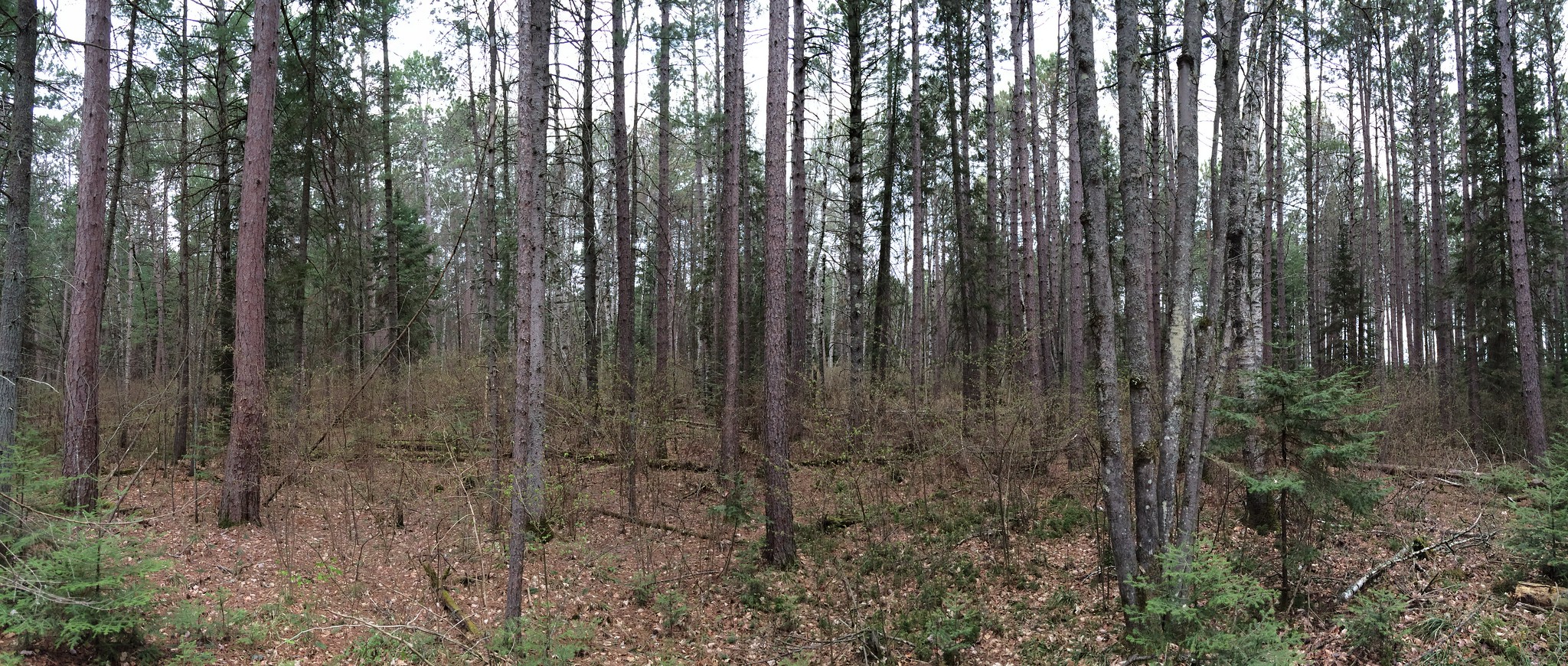
Figure 7: A panoramic image of the untreated portion of the Camp 8 stand, showing a relatively dense understory.
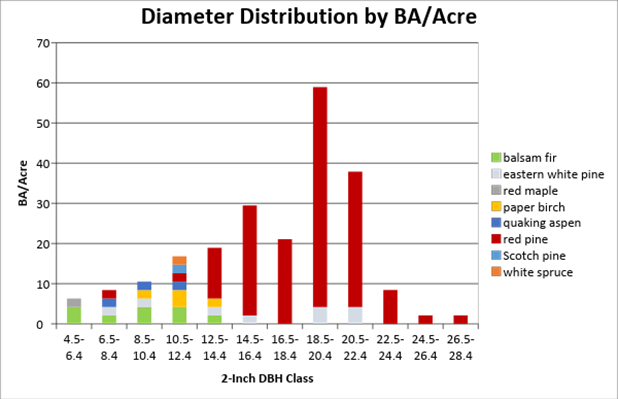
Figure 8: Diameter distribution by BA/acre of the untreated area of Camp 8 in 2018, cruised with a BAF of 40
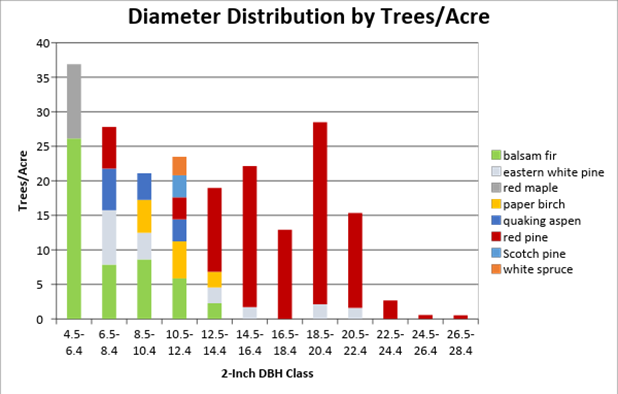
Figure 9: Diameter distribution by trees/acre of the untreated area of Camp 8 in 2018, cruised with a BAF of 40
Plans for future treatments
The Cloquet Forestry Center management plan does not call for any treatments in this stand.
Other notes
It is unknown whether or not the fuel type in the treated side could effectively carry a surface fire. As of 2018, the understory and litter layer is mostly dominated by paper birch, beaked hazelnut, and red maple.
Summary / lessons learned / additional thoughts
The mechanical treatment demonstrates that the open understory structure historically created by a high-frequency surface fire regime can be effectively restored but that regular re-entries are needed to maintain this structure. However, it also appears that this treatment might not effectively restore surface and subsurface composition and nutrient conditions because it does not volatilize the litter and eliminate root reserves of deciduous shrubs and trees. This could still prove to enrich the historically xeric site, resulting in long-term changes in nutrient cycling and microorganism and macroorganism composition. The transition currently underway on the site, particularly in the Armillaria root rot pocket, is clearly visible in Photograph 8, showing prolific growth of red maple in the expanding red pine mortality gap. It is likely that only returning surface fire to the site could effectively restore these processes; surface fire would ideally be returned within 5 years of the structural treatment.
Submitted by
Kyle Gill
Kyle has been the CFC forest manager and research coordinator since 2015. He enjoys exploring stand development, silviculture, and the inherent biases that we bring to decision making. He feels it is important to see himself and other humans as community members of forested and non-forested ecological communities.
Lane Moser
Lane got his passion for silviculture over the course of achieving his B.S. and M.S. in forestry from the University of Minnesota. He has worked at the Sustainable Forests Education Cooperative since early 2022. Lane is also currently pursuing a PhD at the University of Minnesota; his specialization and research interests include both silviculture and soil health and structure, particularly as they relate to the aspen cover type.
